
While there are many parts of your home that are important to your comfort and well-being, none are arguably as crucial as your roof. Along with keeping you and your family dry during rainstorms or when snow is falling, it also plays a big role in keeping your home properly heated and cooled. But if you’re like many people today, you may be interested in how to make your home, and in particular your roof, more environmentally friendly. If you want your roof to help the environment, here are four options to consider.
Ventilation and Insulation
If you want your roof to work well for the environment, make sure it is properly insulated and ventilated. In doing so, you’ll have an environmentally-efficient home that will regulate heating and cooling fumes from getting released into the atmosphere. Also, proper ventilation and insulation will help reduce your energy bill each month.
Install Rain Guards
Becoming more popular in recent years, rain guards being installed on roofing helps the environment in many ways. For starters, if you have a vegetative roof and have plants growing there, rain guards keep water from falling to the ground. Instead, it will allow the water to drain into the roof’s plant soil, helping with plant growth.
Select Metal Roofing
While vegetative roofs have started to become popular with many people, the use of metal roofing on homes has skyrocketed over the past decade. Very durable and requiring little maintenance, metal roofs can last for 50 years or even longer. In addition, the metal coating reflects solar energy, thereby helping to keep your home more comfortable in hot weather. Finally, the metal itself can be recycled, unlike asphalt shingles that almost always find their way into landfills.
Regular Roof Maintenance
Even if you don’t have a metal or vegetative roof, simply performing regular maintenance on your existing roof will help make it more environmentally friendly. For example, if you keep your guttering and roof clean, this will allow it to last longer. If everyone does this, less and less roofing material winds up in landfills. Also, by keeping your home’s gutters clean so that water can easily pass through downspouts, this will decrease the presence of germs, rodents, and insects, lessening the chances of disease and other environmental issues.
By doing your part to make your roof environmentally friendly, the world around you will be a bit more cleaner and healthier for the next generation.


